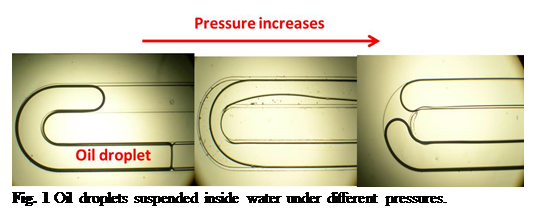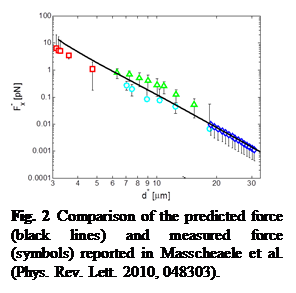58th Annual Report on Research 2013 Under Sponsorship of the ACS Petroleum Research Fund
Reports: DNI951561-DNI9: Studies of Streaming Potentials Generated by a Two-Phase Flow with Applications to Detecting Water Encroachment towards Oil Wells
Hui Zhao, PhD, University of Nevada (Las Vegas)
| .
|
 Oil reservoirs with bottom water layers exhibit high
oil recovery due to supplemental energy imparted by the aquifer. A large oil
production rate may simultaneously drive oil from the reservoir and water from
the underlying aquifer towards the lower pressure sink created by the oil well.
Typically water moves in a cone shape and such phenomenon is termed water
coning referring to the deformation of a water-oil interface which is initially
horizontal. Water coning is a serious problem in managing reservoir recoveries
since water mobility is much larger than oil mobility in porous rock and water
phase may become so dominant in total production to the extent that further
operation of the well becomes not economically valuable and the well has to be
abandoned. For economic and environmental benefits, solutions have been
proposed to prevent or minimize water coning during oil production including
artificial barriers, downhole water sink, and
injection of polymers or gels. However, in order to control water coning or
minimize the impact of unwanted water in oil wells, an effective technique
monitoring water flow into oil wells is the first and key step.
Oil reservoirs with bottom water layers exhibit high
oil recovery due to supplemental energy imparted by the aquifer. A large oil
production rate may simultaneously drive oil from the reservoir and water from
the underlying aquifer towards the lower pressure sink created by the oil well.
Typically water moves in a cone shape and such phenomenon is termed water
coning referring to the deformation of a water-oil interface which is initially
horizontal. Water coning is a serious problem in managing reservoir recoveries
since water mobility is much larger than oil mobility in porous rock and water
phase may become so dominant in total production to the extent that further
operation of the well becomes not economically valuable and the well has to be
abandoned. For economic and environmental benefits, solutions have been
proposed to prevent or minimize water coning during oil production including
artificial barriers, downhole water sink, and
injection of polymers or gels. However, in order to control water coning or
minimize the impact of unwanted water in oil wells, an effective technique
monitoring water flow into oil wells is the first and key step.The objective of this project is to investigate the feasibility of measurements of streaming potentials to detect water encroachment since when water approaches an initially oil-filled reservoir, it induces changes in the streaming potential.
|
|
 During this reported period, we made
progress in both experimental and numerical aspects of the project. Experimentally,
we studied the oil droplet motions in a serpentine
channel geometry similar to the porous structure (Fig. 1). At small pressures, the change of the channel geometry
does not break the oil droplet and the oil droplet maintains a bullet shape. As
the pressure increases, the shear force near the curved surface starts to
squeeze the droplet. At even higher pressures, the droplet breaks into two
droplets. To measure the streaming potential, we randomly injected oil droplets
into a water stream which is driven by a constant pressure and monitored the
streaming potential. Our experiments showed that the streaming potential is significantly
changed by the presence of the oil droplet in the serpentine channel.
During this reported period, we made
progress in both experimental and numerical aspects of the project. Experimentally,
we studied the oil droplet motions in a serpentine
channel geometry similar to the porous structure (Fig. 1). At small pressures, the change of the channel geometry
does not break the oil droplet and the oil droplet maintains a bullet shape. As
the pressure increases, the shear force near the curved surface starts to
squeeze the droplet. At even higher pressures, the droplet breaks into two
droplets. To measure the streaming potential, we randomly injected oil droplets
into a water stream which is driven by a constant pressure and monitored the
streaming potential. Our experiments showed that the streaming potential is significantly
changed by the presence of the oil droplet in the serpentine channel. Numerically, we have implemented the phase-field method to track the motion of a droplet suspended in another liquid in the curved surface in the presence of the electric field. The Laplace equation accounting for the electric field has been incorporated into the model. The model is capable of studying electrokinetic phenomena under the limit of thin double layers. The modeled droplet shape shows good agreement with experimental data.
In addition, we also studied the interaction of colloidal particles similar to soil particles at the oil-water interface. We theoretically examined the particle-particle interaction force and compared favorably with reported experimental results (Fig. 2). Due to strong electrostatic forces, particles are stably separated at the oil-water interface. Colloidal particles stabilizes the oil-water interface and prevent droplet coalescing which has an important implication in encroachment.
The ACS PRF Doctoral Investigator Grant has a significant impact on PI's career. The grant helped the PI to obtain many important results to study electrokinetic phenomena and gather preliminary results for his NSF proposal on relevant topics. The project supported two graduate students and one postdoc scholar.
Copyright © 2014 American Chemical Society











